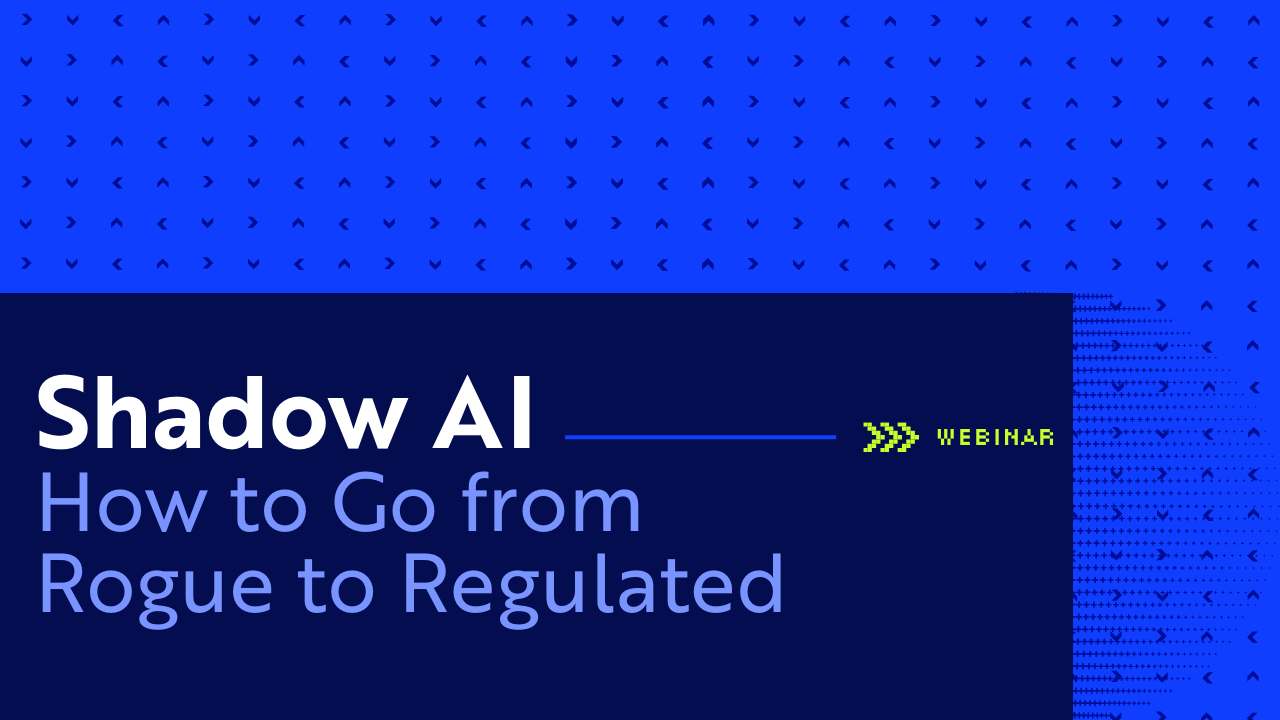As a technology leader, your mandate is clear: enable the business while managing risk. The rapid, bottom-up adoption of Artificial Intelligence—what we in the security field call Shadow AI—has created a critical, unmanaged surface area that directly conflicts with this goal.
Shadow AI is the use of unauthorized or unvetted generative AI tools, large language models (LLMs), browser plugins, and automation scripts by employees across the enterprise. These tools often bypass traditional IT procurement and security oversight, introducing profound AI Cyber Security Risk without any compensating controls.
Ignoring Shadow AI is no longer an option. It demands a structured, governance-first response from the IT leadership—a move to formalize adoption and transform a rogue threat into a strategic asset. The scope of this challenge is staggering: a 2025 EY Work Reimagined Survey reveals that 77% of employees admit to using GenAI at work (often without disclosure), and yet only 28% of leaders say their organization has a formal GenAI usage policy. This massive chasm between adoption and governance is the primary source of modern enterprise risk.
The Vectors of Unmanaged AI Adoption: How Shadow AI Infiltrates Businesses
The Critical Impact: Compliance Failure & Data Integrity
The Strategic Response: A Three-Pillar Framework for AI Governance
Co-Managed Strategy: Integrating Shadow AI Controls with Your Existing Stack
Strategic Partnership: Accelerating Your Secure AI Roadmap
Frequently Asked Questions About Shadow AI
The Vectors of Unmanaged AI Adoption: How Shadow AI Infiltrates Businesses
The challenge of Shadow AI stems from its sheer accessibility. Unlike traditional enterprise software that requires installation and licensing, many potent AI tools exist as free, web-based services, simple browser extensions, or low-code automation platforms.
1. Generative LLMs and External Services
The most common and immediate risk vector is the casual use of public-facing generative AI tools. Employees are leveraging these tools for everyday tasks: summarizing meetings, drafting marketing copy, debugging code snippets, or analyzing spreadsheets.
The danger lies in the input. Every time an employee pastes internal documents or client PII into the prompt window, they are effectively publishing that data to an unregulated third party. This creates an enormous vulnerability, as the data classification—which may be confidential, restricted, or regulated—is entirely ignored by the user.
A 2025 IBM Cost of a Data Breach Report found that one in five organizations reported a breach due to Shadow AI, and these incidents cost an average of $670,000 more than standard data breaches. This prevalence underscores the necessity of establishing clear AI policies for businesses immediately.
2. Browser Plugins and Extensions
Less visible, but equally dangerous, are the browser-based AI plugins. These extensions promise productivity gains by integrating AI directly into a user's workflow—for instance, summarizing emails within Gmail or generating responses in a CRM.
-
The Threat: These plugins often require broad permissions, granting them access to the data processed by the browser across multiple tabs and applications. An unvetted plugin can act as a sophisticated form of spyware, capturing corporate data and transmitting it to external servers, creating a covert data exfiltration channel that bypasses perimeter defenses.
3. Low-Code/No-Code Automation and Bots
The democratization of automation platforms (e.g., Zapier, Microsoft Power Automate, etc.) allows non-technical staff to build sophisticated workflows that connect business applications. When AI capabilities are integrated into these bots—for tasks like invoice processing or document classification—they gain access to sensitive back-end systems.
-
The Threat: An improperly configured automation bot, especially one utilizing an external AI API, can introduce logic flaws or grant access to systems (like HR or Finance) without adequate credential management or audit trails. This dramatically amplifies the blast radius of any security incident. As Gartner predicts, by 2027, 75% of employees will acquire, modify, or create technology outside IT’s visibility, confirming that bottom-up adoption is now the prevailing force in enterprise technology.
The Critical Impact: Compliance Failure & Data Integrity
For the IT Director, the consequences of uncontrolled Shadow AI adoption are measured in regulatory fines, brand damage, and irretrievable loss of data control. The core conflict is between the efficiency promised by AI and the mandated confidentiality requirements of modern business.
Data Privacy and Irreversible Leakage
Unmonitored AI tools create a direct threat to AI and data privacy for small businesses, particularly those operating in regulated sectors. Loss of control is absolute when an employee inputs sensitive data into a public LLM.
-
The Irreversibility: If protected health information (PHI) or proprietary business information is entered into a public LLM, that data is often ingested to train the model. This makes it impossible to guarantee its permanent destruction or prove that the data is not being used to train the general public model—a clear violation of HIPAA and CCPA requirements.
CASE IN POINT
The Legal Firm's Exposure:Consider a mid-sized legal firm where a paralegal, pressed for time, pastes privileged client communication into a public LLM for summarization and drafting a response. That single act breaches attorney-client privilege, a far more severe consequence than a typical data breach. The compliance failure is immediate, non-recoverable, and can lead to sanctions or loss of licensure, demonstrating the severity of the AI Cyber Security Risk.
Audit Trail and Governance Failures
Compliance frameworks like SOC 2 or PCI DSS demand clear, traceable audit logs for all systems that interact with sensitive data. Shadow AI fundamentally undermines these controls:
-
Lack of Visibility: There is no logging or audit trail of the data exchanged between the employee and the external AI service. When an auditor asks to prove data integrity or access control, the IT team has no evidence to provide.
-
Unvalidated Processes: If an employee uses an unmonitored AI tool to classify a financial transaction or review a legal document, the process itself is unvalidated and outside the scope of formal change management. The AI’s output is a "black box," introducing an unacceptable level of risk into critical business processes.
To manage this, the U.S. National Institute of Standards and Technology (NIST) continually emphasizes the need for comprehensive AI Risk Management Frameworks, highlighting that regulatory oversight will only increase, making proactive control of Shadow AI a strategic imperative, not an operational afterthought.
The Strategic Response: A Three-Pillar Framework for AI Governance
As IT Director, your role is to move from a reactive security posture to a proactive, governance-driven framework. This requires executive alignment and a structured approach to managing AI as a core technology asset. This is how to use AI safely in the workplace.
Related Webinar- Shadow AI: How to Go From Rogue to Regulated
Pillar 1: Policy and Education
The foundational pillar involves establishing clear boundaries and ensuring enterprise-wide understanding.
-
Establish Clear AI Policies for Businesses: Publish clear, actionable policies defining acceptable use, prohibited data types, and the official channels for requesting AI tools. Explicitly forbid the input of any Level 3 (Confidential) or Level 4 (Restricted) data into any unapproved LLM.
-
Mandatory Training: Training must be mandatory, scenario-based, and ongoing. It should explain not just what is forbidden, but why (the specific risk of data leakage and compliance failure), fostering a culture of compliance where employees become partners in managing AI and data privacy for small businesses.
Pillar 2: Technical Discovery and Control
You cannot govern what you cannot see. Your security stack must be modernized to detect the signatures of Shadow AI.
-
Network and Endpoint Discovery: Utilize network monitoring tools and Endpoint Detection and Response (EDR) to identify applications and services that are communicating with known AI vendor APIs (e.g., OpenAI, Anthropic, Gemini).
-
DLP Integration: Configure your Data Loss Prevention (DLP) solution to specifically look for sensitive data patterns (e.g., SSNs, PII, proprietary code snippets) being pasted or uploaded to suspicious AI services. It's essential to note that only 17% of companies can actually stop data uploads to AI platforms, highlighting the urgent need for custom-tuned technical controls.
-
The AI Register: Implement a mandatory registry for any employee-requested AI tool. IT must review the vendor’s data retention, encryption, and training policies before approval.
Pillar 3: Formal Risk Quantification
The most strategic action is to quantify the risk exposure and create an executive-level roadmap for remediation. This is achieved through a formal, dedicated AI cybersecurity assessment.
Co-Managed Strategy: Integrating Shadow AI Controls with Your Existing Stack
As an IT leader, your challenge is implementing these governance structures without overtaxing your team. This is where a co-managed approach with CompassMSP provides a massive injection of bandwidth and expertise. We specialize in making your existing security investments work harder against emerging threats.
Our vCISO and SOC teams focus on technical integration points that immediately impact Shadow AI visibility and control:
-
Custom DLP Rulesets: We guide your team on writing and deploying highly specific DLP rules within your existing ecosystem (e.g., Microsoft Purview, Google Workspace, or Proofpoint). This ensures that attempts to copy-paste classified data into the chat window of known AI services trigger an immediate, high-priority alert, minimizing data leakage.
-
SIEM/XDR Alert Tuning: Our 24/7 U.S.-based Security Operations Center (SOC) assists in creating custom correlation rules within your SIEM/XDR platform (e.g., Splunk, Sentinel, CrowdStrike). These rules look for unusual network traffic patterns or API calls consistent with mass data transfers to external, unapproved AI endpoints, allowing you to instantly map the scope of Shadow AI usage.
-
Co-Managed Vendor Vetting: We provide a structured framework for vetting new AI vendors requested by the business, completing the necessary security questionnaires, and analyzing their data policies against your compliance mandates (HIPAA, SOC 2, etc.), freeing up your internal team to focus on daily operations.
By leveraging our strategic advisory and 24/7 monitoring capabilities, you gain the deep expertise required to manage AI cybersecurity without the prohibitive cost or timeline of hiring dedicated internal specialists.
Strategic Partnership: Accelerating Your Secure AI Roadmap
At CompassMSP, we understand that your team is managing a bandwidth crisis while confronting a new generation of sophisticated threats. Our mission is to ensure technology supports people, not slows them down. This principle is at the heart of our approach to AI cybersecurity.
We combine the scale of a national provider with the dedicated, vertical expertise needed to manage highly regulated environments. Our strategic guidance, delivered through our dedicated vCISO service, is designed to align your technology strategy with your business outcomes.
We don't just secure your environment; we provide executive-level advisory that translates complex technical risks—like Shadow AI—into clear, measurable ROI for your leadership. Our 24/7 U.S.-based Security Operations Center (SOC), coupled with AI-driven threat detection, ensures that you have the specialized skills and round-the-clock support required to manage this rapidly evolving landscape.
Actionable Next Step: Secure Your AI Future
The first and most important step in controlling your AI Cyber Security Risk is gaining full visibility.
Start with our ShadowAI playbook and on-demand webinar to take the first step toward channelling, rather than trying to control AI in your organization.
Ready to partner with us to transform your AI risk into a competitive advantage? Reach out here.
Frequently Asked Questions About Shadow AI
Q: What is Shadow AI and why is it a significant security concern?
Shadow AI refers to the use of artificial intelligence tools, especially generative models like LLMs, that are adopted by employees without the knowledge, approval, or oversight of the central IT or security team. It is a significant concern because it leads to data leakage, as employees input proprietary or sensitive data into external, unvetted systems, bypassing all corporate security, data privacy, and compliance controls, thus introducing a severe AI Cyber Security Risk.
Q: How does Shadow AI differ from traditional Shadow IT?
While traditional Shadow IT primarily involved unapproved hardware or software installation (like a personal cloud drive or rogue server), Shadow AI specifically involves unapproved data processing by a third-party AI model. The risk is magnified because AI tools actively learn from the input data, potentially embedding sensitive corporate information into their publicly accessible models, which is a much graver compliance and intellectual property threat.
Q. Can small to mid-sized businesses (SMBs) truly be impacted by Shadow AI?
Yes, SMBs are often more vulnerable to Shadow AI than large enterprises. Since SMBs often have fewer dedicated resources for governance and a smaller security team, the adoption of rogue AI can spread faster and more widely without detection. For SMBs operating under regulations like HIPAA or PCI DSS, a single data leak incident caused by Shadow AI can result in disproportionately severe compliance fines and business disruption, which are magnified by the lack of dedicated resources.
Q What are the key compliance risks associated with unmonitored AI usage?
The key compliance risks revolve around data confidentiality and integrity. The use of unmonitored AI tools threatens adherence to GDPR, HIPAA, SOC 2, and CCPA. Specifically, there is a risk of violating data sovereignty and handling requirements, as the unmonitored AI model may store or process sensitive data in unapproved locations or fail to provide the required audit trails for sensitive data access, directly jeopardizing legal and regulatory standing.
Q: What is the first step an IT Director should take to manage Shadow AI?
The most critical first step is to establish and formally communicate clear AI policies for businesses. This policy must explicitly define what types of data (e.g., proprietary code, PII, financial forecasts) are forbidden from use in public or unapproved AI tools. This must be backed by immediate, mandatory security awareness training to educate all employees on the severe AI and data privacy for small businesses risks involved.
Q. What technical tools are effective in detecting Shadow AI?
Effective technical tools focus on network and endpoint visibility. Data Loss Prevention (DLP) systems can be configured to block or flag uploads of classified documents to known external AI platform URLs. Additionally, Network Traffic Analysis (NTA) and Cloud Access Security Brokers (CASB) can monitor network connections to identify and log communication with third-party generative AI services, helping to map the scope of the exposure.
Q: How can we ensure employee productivity is maintained while implementing strict AI controls?
The goal is not to eliminate AI but to enable it securely. To maintain productivity while implementing controls, IT leadership must proactively identify and procure secure, enterprise-grade AI solutions that meet corporate compliance and security requirements. By providing an approved and governed pathway, you show employees how to use AI safely in the workplace, channeling their desire for productivity into sanctioned, low-risk tools.
Q: What role does the CISO or vCISO play in managing Shadow AI?
The CISO or vCISO is the executive owner of the AI Cyber Security Risk management program. Their role is to establish the strategic framework, which includes defining the risk tolerance, developing comprehensive governance and compliance roadmaps, and translating technical risks into business impact for the board. They provide the executive-level guidance needed to align AI cybersecurity efforts with overall business strategy.
Q: Why is a dedicated AI Cybersecurity Assessment important for a business?
A dedicated AI Cybersecurity Assessment provides an objective, data-driven measure of the organization’s current exposure to Shadow AI. It goes beyond simple policy checks by technically inventorying unmonitored tools, identifying specific data leakage points, quantifying the resulting compliance gaps, and delivering a prioritized action plan. This assessment transforms an amorphous risk into a manageable, budgeted security project.
Q: How should an organization approach training employees on AI usage and policy?
Training must be mandatory, scenario-based, and ongoing. It should explain not just what is forbidden, but why (i.e., the specific risk of data leakage and compliance failure). Key components include training on data classification, examples of secure versus insecure use cases, and clear guidelines on the procedure for reporting and requesting new AI tools, fostering a culture where employees are partners in implementing AI policies for businesses.







